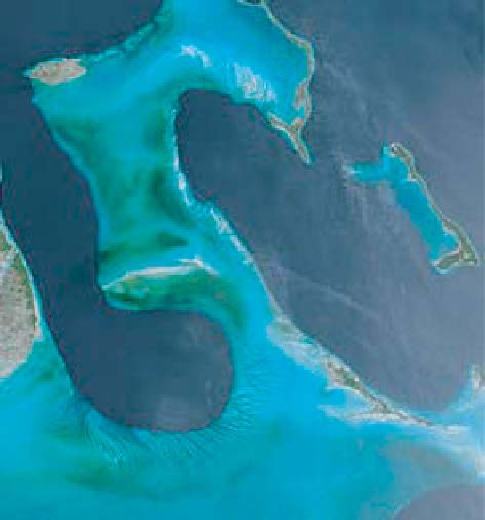Geology Reference
In-Depth Information
strong enough to sustain measured average wave
speeds of ~1 m s
1
(Eckman and Andres, unpub-
lished data), making these sites moderate- to high-
energy environments.
Sediments in the Exuma Cays chain are
dominated by shallow-water carbonates, in par-
ticular ooids, skeletal and coated grains (Ginsburg
et al.
, 1958; Traverse & Ginsburg, 1966). Skeletal
grains and nuclei of coated grains originate from
surrounding reefs and shallows. Shallow-water
sediment at both Highborne Cay and Stocking
Island consists of well-sorted sand-sized sediment
(on average 100-270 μm). Large and highly mobile
shoals and sand waves are dominantly found in
association with strong tidal currents within
tidal channels (Gonzalez & Eberli, 1997), and, as
observed on Highborne Cay, oceanward of frin-
ging reefs (Andres & Reid, 2006).
N
Nassau
Highborne Cay
Exuma
Sound
Lee Stocking Island
Stocking Island
50 km
Great Bahama Bank
Reef development at Stocking Island
On Stocking Island, a small island, 2 km east of
Georgetown (Great Exuma Island), a reef complex
approximately 50 m wide extends for 3 km along
the eastern beach (Figs 1 and 2). The reef facies
and internal reef structure are well-documented
based on mapping and a suite of shallow cores
(Reid & Browne, 1991; Macintyre
et al.
, 1996);
these fi ndings are summarized below.
Three zones are described in the Stocking
Island complex: back reef, reef fl at and fore reef.
Stromatolites dominate the back reef area, occur-
ring as metre-sized, sometimes coalescing tabular
forms and dome-shaped heads (0.5-1 m diameter)
with a maximum relief of ~0.5 m. They form
elongated shapes parallel to the outer reef crest/
edge, cut by channels reminiscent of the spur and
groove structure in coral reefs (Fig. 2). The reef
fl at is characterized by hard and uneven surfaces
of microbial mat in which a number of differ-
ent cyanobacteria were documented (Macintyre
et al.
, 1996). Various macroalgae and turf commu-
nities dominate the seaward part of the reef fl at.
The fore reef is dominated by the coralline alga
Neogoniolithum strictum
(Steneck
et al.
, 1997).
A few metres seaward of the coralline algal plat-
form numerous pinnacles and ridges rise from
a sand-swept, smooth rocky bottom. These blade-
shaped pinnacles have smooth hard surfaces
sometimes covered with macroalgae growth and
cyanobacterial mat.
Stratigraphy and evolution of the reef is based
on a single shallow-core transect, and dating of
discrete samples. The 2.1 m thick Holocene reef
Fig. 1.
Overview of the Exuma Cays, Bahamas; a chain of
islands on the western rim of the Exuma Platform facing
the deep waters of Exuma Sound. Locations of Highborne
Cay, Lee Stocking Island and Stocking Island indicated
with red arrows.
Cays: Stocking Island (Macintyre
et al.
, 1996; Steneck
et al.
, 1997, 1998) and Highborne Cay (Reid
et al.
,
1999) located in the southern and northern ends
of the Exuma chain, respectively (Fig. 1).
The Exuma Cays
The Exuma Cays comprise a northwest-southeast-
trending island chain in the central Bahamas. They
are bordered to the west by the shallow (<10 m)
Exuma Bank and to the east by a narrow terraced
shelf dropping off to depths of up to 2000 m into
the Exuma Sound (Fig. 1). Surface water in Exuma
Sound is characterized by sea-surface tempera-
tures ranging from 20°C to 28°C in winter and sum-
mer, respectively and normal marine salinities of
~35 psu (Droxler
et al.
, 1988). Tides are diurnal and
range within 0.7-1 m. Surface waters are saturated
with respect to both aragonite and calcite (Droxler
et al.
, 1988; Swart & Eberli, 2005). Climatic condi-
tions are dominated by the southeasterly to east-
erly trade winds with an average wind speed of
10-15 knots. Waves and wave energy are highly
dependent on wind direction and strength. Large
waves (>1 m) occur mostly in association with
strong cold frontal systems and occasional
hurricanes. Steady trade winds are constant and











